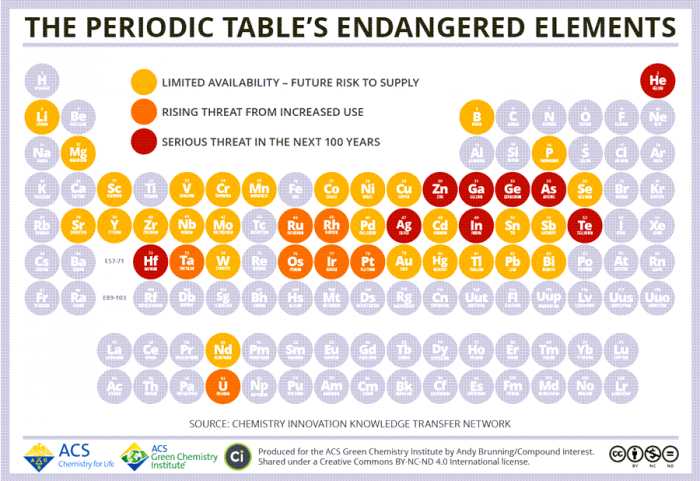This post will highlight some recent works discussing the scarcity of various elements on the periodic table, including one that caught some people by surprise because it’s one of the more familiar elements in our daily lives.
From the European Chemical Society, this poster provides a nice visual of the natural elements by abundance and scarcity, including the ~30 elements used in our phones.(1)

The Royal Society of Chemistry also released an interactive Periodic Table where you can hover over the elements to see each one’s supply risk.(2)
For Nature Chemistry, Bruce Gibb wrote about the US Department of the Interior’s official list of 35 critical minerals and elements, “meant to augment, not replace,” other lists and stockpiles of important and strategic minerals.(3) That list, with links to data and reports from the National Minerals Information Center, can be found on the USGS website.(4)
The Compound Interest Blog created a similar table in 2015.

While there’s some variation between the two tables in terms of how threatened some of these threatened elements are, both point out that the scarcity of helium will be a serious threat in the next 100 years. The helium shortage has made extra headlines this year because of Party City closures,(6) though the company said that was not due to helium shortages (while acknowledging some stores had challenges meeting the demand).(7) Bruce Lee’s piece in Forbes, also published this May, mentions the impact on balloons as well, but focuses more in helium’s importance in meicine and research.(8)
But the impending helium shortage is not news. The Washington Post reported on it a few years ago, along with the U.S. Federal Helium Reserve and a discovery of a new helium gas field in Tanzania.(9) Nature Physics also covered it in 2014, with a good summary of the history of the our helium use, the impending shortage, and attempts to address availability and dependency, as well as the value of helium beyond the balloons.
“Biologists and chemists require high-resolution superconducting magnets for NMR and mass spectrometry; physicists and materials scientists need it in research discovering quantum materials and new physical principles, building devices for metrology and quantum information; in medicine, radiologists must have helium for their MRI magnets. But addiction to helium is particularly strong among physicists. We need its cryogenic properties to operate stable superconducting magnets that generate high magnetic fields, and to work at sub-kelvin temperatures. Our dependency on liquid helium is directly related to its versatility as a cryogenic liquid. It does not freeze even at absolute zero temperature. It has very large cooling power, essentially vibration-free.”(10)
References
1. Element Scarcity: EuChemS Periodic Table. European Chemical Society,
https://www.euchems.eu/euchems-periodic-table/ (accessed 2019-09-24).
2. Periodic Table. Royal Society of Chemistry. http://www.rsc.org/periodic-table (accessed 2019-09-24).
3. Gibb, B. C. Critical Chemical Commodities. Nat. Chem. 2019, 11, 99-101. DOI: 10.1038/s41557-018-0205-6
4. Interior Releases 2018’s Final List of 35 Minerals Deemed Critical to U.S. National Security and the Economy. U.S. Department of the Interior, U.S. Geological Survey, 2018-05-18.
https://www.usgs.gov/news/interior-releases-2018-s-final-list-35-minerals-deemed-critical-us-national-security-and (accessed 2019-09-24).
5. The Periodic Table’s Endangered Elements. Compound Interest, 2015-08-15.
https://www.compoundchem.com/2015/08/19/endangered-elements/ (accessed 2019-10-22).
6. Daley, J. The Future of Helium Is Up in the Air. Smart News. Smithsonian, 2019-05-20.
https://www.smithsonianmag.com/smart-news/future-helium-air-180972220/ (accessed 2019-10-24).
7. Murphy, H. The Global Helium Shortage Is Real, but Don’t Blame Party Balloons. New York Times, 2019-05-16.
https://www.nytimes.com/2019/05/16/science/helium-shortage-party-city.html (accessed 2019-10-24).
8. Lee, B. Y. How The Helium Shortage Will Impact Your Healthcare. Forbes, 2019-05-24.
https://www.forbes.com/sites/brucelee/2019/05/24/there-is-a-helium-shortage-what-you-need-to-know/ (accessed 2019-10-24).
9. Harvey, C. The World Is Running Dangerously Low on Helium. This Discovery Reinflates Our Supply. Washington Post, 2016-06-28.
https://www.washingtonpost.com/news/energy-environment/wp/2016/06/28/the-world-is-running-dangerously-low-on-helium-this-discovery-reinflates-our-supply/ (accessed 2019-10-25).
10. Halperin, W. P. The Impact of Helium Shortages on Basic Research. Nat. Phys. 2014, 10 (7), 467-470. DOI: 10.1038/nphys3018

